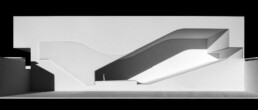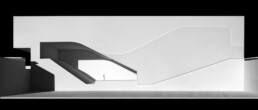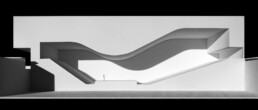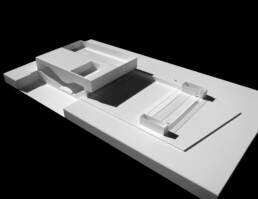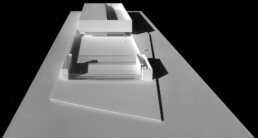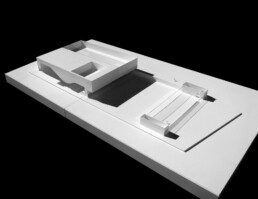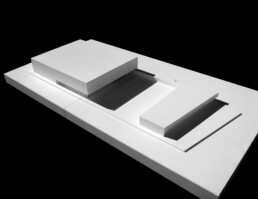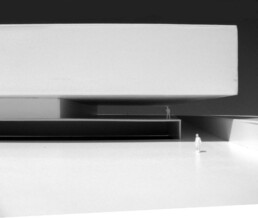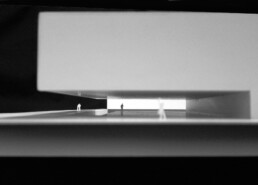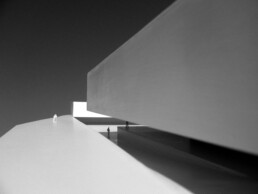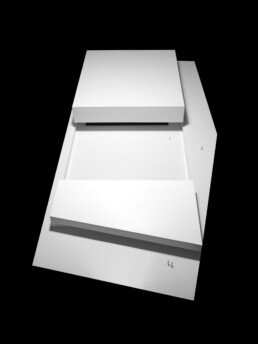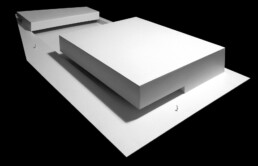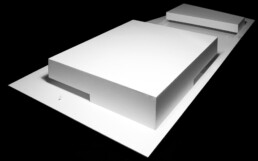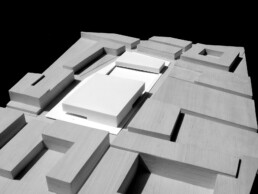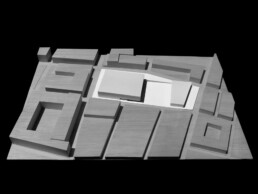El proyecto consiste en hacer convivir el estudio de un músico con su vivienda. Ubicado en una zona de viviendas cerca de Valencia, donde las casas vecinas están muy próximas entre ellas.
The proposal involves two elements that, as a tuning fork, give shape to an open square. A square that, alike a sound box, allows the city’s involvement in the cultural life taking place in the building.
It is an escape from enclosed solutions bringing out the advantages of such site, a great emptiness included in the urban plot delimited by the volumes that define the program, all with an edifice that does not stand out over the whole. The larger volume with the auditorium, exhibition zone and café, is located in the northern part of the site, next to the higher buildings; at a lower level, the square defines it’s elevation by means of the volume that contains administration and library, coexisting with Alfafar’s former plot.
The proposal aims to achieve reconciliation between formal compaction and functional autonomy of each of the parts of the program, as well as the relation of these with the square. Access to the auditorium is easy and clear, and takes place a level over the stalls. The bifocal disposition of the auditorium is determined by its easy adaptation and division depending on the number of spectators and on the event taking place: plays, Movie Theater, conferences… Moreover this disposition also permits a scale control of a hall of such dimensions. The auditorium has orchestra, stage and sound and image cabins.
Access is situated on the same level as the temporary exhibition hall, generating a lobby which guarantees functional independence. In the upper floor, seeking zenith light, the Edgar Neville gallery can be found.
From the access a light slope invites you to enter the square; here and opened towards the entrance, is the café. At the minor volume’s ground level, administration can be found controlling the complex. The library at a lower level, with zenith illumination by means of a high ceiling, is also opened to the public square. At basement level, two parking floors can be found as well as the annexed spaces.
The building is shaped by means of a unitary coating, sometimes perforated, generating a continuous weave. The skylights are solved by means of a constructive detail borrowed from Aalto’s work, increasing them in number and reducing their dimension. This solution does not pretend to be a simple cover, but looks forwards to the determination of a space by means of one of its most important variables: its illumination. The later becomes dramatic and magic in those places where possible (access, circulation areas, workshops, parking’s…); and becomes homogeneous where needed in spaces such as the library and administration.
In the Edgar Neville gallery the illumination possibilities are from a neutral zenith light so desired in a museum to, by means of artificial light and the closing of all skylights, the light perfection demanded in nowadays contemporary art museums. These zenith perforations are also present in the square’s floor, illuminating the parking and giving shape to the square. We can also find them in some vertical surfaces in a minor scale that, together with the horizontality of the volumes, confer the whole the aspect of an elegant sound system.



